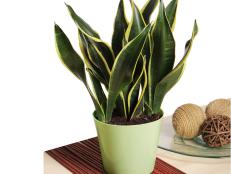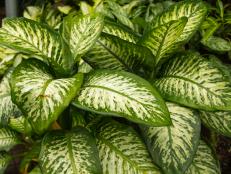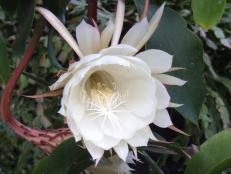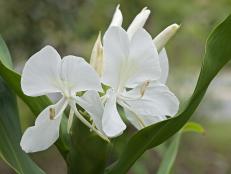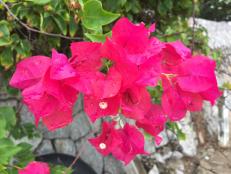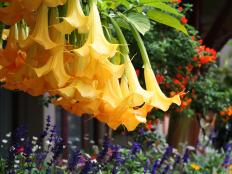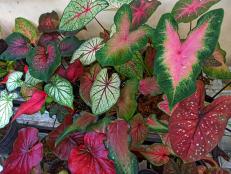Lipstick Plant Care
Lipstick plant, with its flirty, lipstick-tube flowers and cascading stems, is hard to resist. Choose your favorite "lipstick" color: bright red, red-orange, yellow or pink.
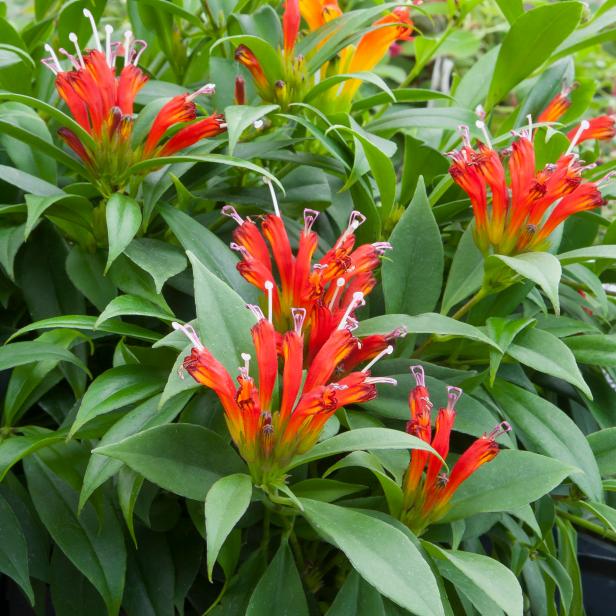
Logee’s Plants for Home & Garden / Logees.com.
Aeschynanthus 'Fireworks' holds its tubular blooms more upright than other lipstick plant varieties.

What is Lipstick Plant (Aeschynanthus radians)?
Native to tropical parts of southeast Asia, lipstick plant is an evergreen vine with tube-shaped flowers and long, cascading stems. Red-flowered varieties give the plants their common names, lipstick plant and lipstick vine, because the blooms look like lipsticks coming out of their tubes. Other varieties have red-orange, pink, or yellow flowers. Usually grown as a houseplant, lipstick plant has thick, green, glossy leaves. It's an epiphyte (a non-parasitic plant that grows on another plant or object) in the Aeschynanthus genus.
Botanical Name: Aeschynanthus radicans
Common Name: Lipstick plant or lipstick vine
Bloom Time: Intermittent
Light Needs: Bright filtered light indoors; full to partial shade outdoors
Hardiness Zones: 10 to 11; recommended as a houseplant
Height and Width: 12 to 36 inches
Growth Rate: Medium
Lipstick plant is easy to grow in containers and especially pretty in hanging baskets (which explains another common name, basket vine). If grown outdoors, lipstick plant is a perennial only in USDA Gardening Zones 10 and 11.
Lipstick Plant Care
Proper lipstick plant care can pay off in almost nonstop flowers, although some varieties bloom most heavily in spring and summer. Hummingbirds often visit Aeschynanthus when they're grown in the garden or moved outside for the summer.
Light Needs
Indoors, lipstick plant needs bright, filtered light. Direct sunlight can burn the leaves, while insufficient light can make them drop and lead to few or no flowers. Outdoors, partial to full shade is ideal.
Soil
In its native environment, lipstick plant grows on mossy branches, in the cracks of rocks and around trees where leaf litter and other forest debris has decomposed into a small amount of soil. To grow it as a houseplant, plant lipstick vine in a container with drainage holes and use a well-draining, light, fluffy potting mix. (Add some perlite, coarse sand or pumice if you want to loosen the mix and improve drainage.) Some gardeners use African violet potting mix.
Because lipstick plant is an epiphyte, it rarely thrives in garden soil and dislikes arid conditions like those found in the southwestern US. If you try it in your garden, give lipstick vine a site that drains easily, especially after it rains. The plants do best in neutral to alkaline soil.
Water
While lipstick plant is relatively drought tolerant, never let the soil dry out completely. When the top one or two inches of soil feel dry, it's time to water. Ideally, the roots should stay slightly moist but never wet. When you water, pour the water directly onto the soil or bottom-water your lipstick plant (that is, place the pot, which should have at least one drainage hole, in a saucer of water to let the soil absorb the water). Avoid getting the foliage wet and drain any excess water that accumulates if there's a saucer or tray under your plant.
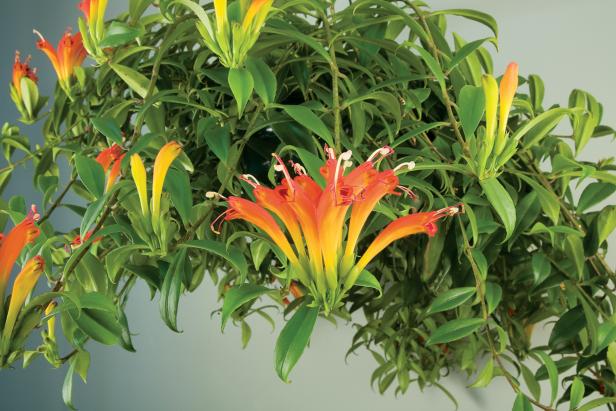
Logee's Plants for Home & Garden / Logees.com
Lipstick plants, like this orange one (A. x splendidus), are members of the Gesneriad family, like African violets.
Humidity
Lipstick plant is a jungle dweller and needs more humidity than most homes offer, so mist it regularly or run a humidifier made for indoor plants. You can also increase the humidity around lipstick vine by placing the container on a tray filled with pebbles and a little water; don't let the water touch the bottom of the pot, which can cause root rot. Bathrooms and kitchens usually have more moisture in the air than other rooms, so they're good locations for Aeschynanthus. Keep lipstick vine away from vents and drafts coming from windows and doors.
Fertilizer Needs
In spring and summer, feed lipstick plant with a slow-release granular fertilizer for flowering plants or a general-purpose houseplant fertilizer. Apply as directed on the product label.
Temperature
These tropical beauties prefer temperatures between 65 and 85 degrees and can drop their leaves when the mercury dips below 50 or even 60 degrees. They'll die in a freeze, but some gardeners say their lipstick plants have recovered from short periods of temperatures in the 40s. Very high temperatures and sudden temperature changes will also harm them. If your weather gets extremely hot, move outdoor lipstick plants into a spot with deep shade.
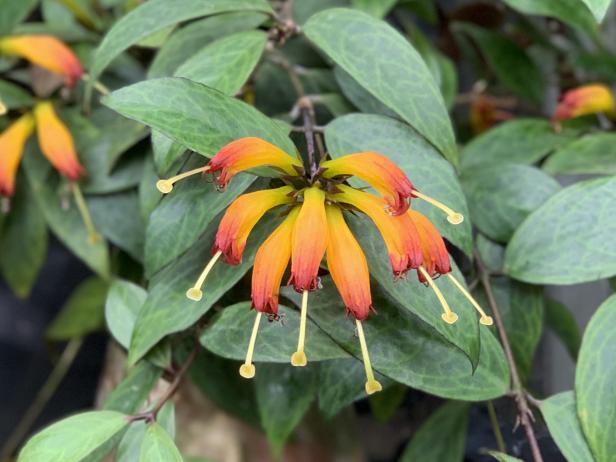
Logee’s Plants for Home & Garden / Logees.com.
'Black Pagoda' lipstick plant has attractive pistils that protrude from the blooms. A pistil is the female reproductive part of a flower.
More About Lipstick Plant Care
Lipstick plant does better when it's root-bound, so don't repot until the container is so full of roots that they're growing out of the drainage holes. Move up one pot size at a time.
Pruning isn't necessary, but you can trim Aeschynanthus with sharp pruners or shears to neaten it up or keep the vines from outgrowing your space. For best results, prune just after the blooms finish — but anytime from spring into early summer is also fine.
Lipstick plant flowers best in the spring and summer. If your plant slows down or stops blooming, you may need to adjust your lipstick plant care practices. Be sure your plant has enough light, use a good quality fertilizer and be careful not to overwater. To encourage denser growth and more blooms, cut the stems back to 6 to 8 inches long after the flowers fade.
Lipstick Plant Pests and Diseases
Lipstick plants don't often suffer from pests or diseases, but common problems that plague other houseplants can occur. Knock off spider mites, mealybugs and aphids with a gentle spray of water from your kitchen sink, tub or hose, or spray with Neem oil or organic insecticidal soap. If you see only a few mealybugs, wipe them off with a cotton ball dipped in rubbing alcohol.
Another option for banishing indoor pests: Mix a teaspoon of mild dishwashing soap with a quart of water and spray your plants. To help prevent diseases like Botrytis blight and leaf spot, don't get water on lipstick plant leaves and remove the flowers when they fade.

Logee’s Plants for Home & Garden / Logees.com.
Epiphytes like this lipstick plant, 'Thai Pink', take nutrients from the organic debris in their native environment.
Propagating Lipstick Plant
Lipstick vine is easy to propagate by division (stem cuttings).
- Take 4- to 6-inch cuttings and remove some of the bottom leaves.
- Dip the ends of the cuttings in rooting hormone and insert them into small pots filled with a loose potting mix.
- Keep the mix moist and drape a clear plastic bag over the pots to raise the humidity around them.
- After roots form, usually in a couple of weeks, transplant the cuttings.
You can also propagate stem cuttings in water. Keep the nodes (the places where you removed the leaves) under the water. When 1/2- to 1-inch roots form, pot up the cuttings.
To grow lipstick vine from seeds, which are very fine, sow them in a seed-starting mix. Lightly cover them and keep them in a spot that stays about 70 to 75 degrees until they sprout in about two weeks.
Lipstick Plant Varieties
Although there are more than 100 species of lipstick plants, you may find only a handful for sale at garden centers and nurseries, so search for them online, too. Here are a few to consider:
- Aeschynanthus obconicus 'Mona Lisa' — Bright red flowers open from purple calyxes (leafy structures that surround flower buds). Leaves are lighter green and more rounded than other varieties.
- A. radicans 'Variegata' — Green leaves are streaked with green, yellow, cream and white. Blooms are red-orange.
- A. radicans 'Tangerine' — A newer variety with green leaves and orange-yellow blooms.
- A. radicans 'Rasta' — Also called twisted lipstick plant for its dense, curly foliage. Bright red flowers.
- A. radicans 'Curly' — Scarlet flowers. Leaves are dark green with small, curled and twisted leaflets.
- A. longicaulis 'Black Pagoda' — Bright orange flowers tinted deep orange-red to orange, yellow or green near the calyx.
- A. radicans 'Thai Pink' — Also called pink lipstick plant or A. chinanthus. Bright pink flowers are held upright.
- A. spp. 'Purple Star' — Hot pink to red flowers. This variety grows more upright than other lipstick plants, reaching up to 2 feet.
- A. x splendidus — Orange lipstick plant. Bright orange blooms. Adapts well to the low humidity in most homes.
- A. hybrid 'Fireworks' — Vivid red blooms stand upright and resemble bursts of fireworks. Adapts well to low home humidity.






